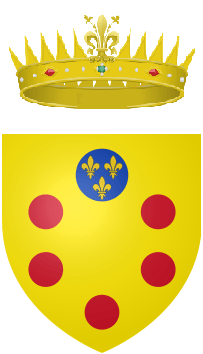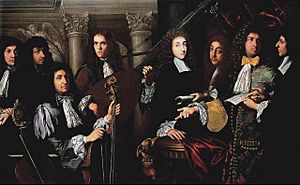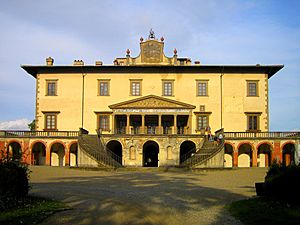Ferdinando de' Medici, Grand Prince of Tuscany facts for kids
Quick facts for kids Ferdinando de' Medici |
|||||
|---|---|---|---|---|---|
 |
|||||
| Grand Prince of Tuscany | |||||
| Tenure | 23 May 1670 – 31 October 1713 | ||||
| Born | 9 August 1663 Pitti Palace, Florence, Tuscany |
||||
| Died | 31 October 1713 (aged 50) Pitti Palace, Florence, Tuscany |
||||
| Burial | Basilica of San Lorenzo, Florence | ||||
| Spouse | Violante Beatrice of Bavaria | ||||
|
|||||
| House | Medici | ||||
| Father | Cosimo III, Grand Duke of Tuscany | ||||
| Mother | Marguerite Louise d'Orléans | ||||
| Religion | Catholicism | ||||
Ferdinando de' Medici (born August 9, 1663 – died October 31, 1713) was an important prince from the Medici family. He was the oldest son of Cosimo III de' Medici, Grand Duke of Tuscany. From 1670 until his death in 1713, Ferdinando was the heir to the Grand Duchy of Tuscany. He held the title of Grand Prince.
Today, Ferdinando is mostly remembered for his love and support of music. He was a very talented musician himself. Some people even called him "the Orpheus of princes." He brought many top musicians to Florence, making it a key center for music. He also supported Bartolomeo Cristofori, which led to the invention of the piano.
Contents
Ferdinando's Early Life and Family
Ferdinando was born in the Palazzo Pitti in Florence. His parents were Cosimo III de' Medici and Marguerite Louise d'Orléans. His mother was a granddaughter of Marie de' Medici.
When Ferdinando was 12, his parents separated in 1675. His mother moved back to Paris. Ferdinando often disagreed with his father. He was then cared for by his grandmother, Vittoria della Rovere.
Ferdinando was a handsome young man. He was a skilled horseman and a very talented musician. He had a beautiful singing voice and played the harpsichord well. He was also a master of counterpoint, which is a complex way of combining different melodies. He could play music he had never seen before perfectly.
Ferdinando's uncle, Francesco Maria de' Medici, was only three years older than him. His uncle had a big influence on Ferdinando's life.
Marriage and Later Years
In 1689, Ferdinando married Violante Beatrice of Bavaria. She was the daughter of Ferdinand Maria, Elector of Bavaria. Violante also loved music and cared deeply for Ferdinando. However, Ferdinando did not feel the same way about her, and their marriage was not happy. They did not have any children.
By 1710, Ferdinando's health began to get worse. The yearly opera shows he supported at Pratolino stopped.
Ferdinando died in 1713. He had no children. His father, Cosimo III, continued to rule until 1723. After Cosimo's death, Ferdinando's younger brother, Gian Gastone, became Grand Duke. Gian Gastone also died without children. Because there were no more heirs in the Medici family, the great powers of Europe decided who would rule Tuscany next. After Gian Gastone's death in 1737, Francis, who was married to Maria Theresa of Austria, became the new ruler. This meant the Medici family's rule over Tuscany came to an end.
Ferdinando's Legacy in Arts and Music
Ferdinando is remembered today for his important role in supporting the arts. He was a great collector of art. He bought famous paintings by artists like Raphael and Andrea del Sarto. He also supported artists such as Giuseppe Maria Crespi and Anton Domenico Gabbiani. Crespi worked for him for a long time at the Pitti Palace.
In 1705, Ferdinando organized the first public art exhibition in Florence. He also befriended poets like Vincenzo da Filicaja.
Ferdinando was most famous for his support of music. He owned the Villa di Pratolino, a country home about 12 kilometers (7.5 miles) outside Florence. Many musical events took place there. From 1679 to 1710, there were annual opera performances, usually in September. These shows were first held in the grand salon. Later, in 1696, a new theater was built on the third floor just for these performances.
Ferdinando invited many famous musicians to Florence. These included Alessandro Scarlatti, Domenico Scarlatti, and George Frideric Handel. Handel's opera Rodrigo was first performed in Florence in 1708.
Ferdinando also wrote letters to Alessandro Scarlatti about details in his operas. In 1711, Antonio Vivaldi dedicated his famous work L'estro Armonico to Ferdinando.
Ferdinando, Cristofori, and the Piano
One of Ferdinando's most lasting contributions was his decision in 1688 to hire Bartolomeo Cristofori. Cristofori was a harpsichord builder from Padua. Ferdinando hired him to take care of his large collection of musical instruments, which had over 75 items.
Ferdinando's support gave Cristofori the money and time he needed to work on his inventions. Cristofori then created several new instruments. The first two were the oval spinet and the spinettone. These were likely made for Ferdinando to play music during performances at Pratolino.
The third instrument Cristofori invented for Ferdinando was the piano. This invention happened around the year 1700. The piano slowly became popular at first. However, it eventually became one of the most important musical instruments in the world. Cristofori built several more pianos for Ferdinando during the rest of the prince's life.
Images for kids
-
Grand Prince Ferdinando de Medici - Giovanni Battista Foggini - 1683 - The Metropolitan Museum of Art - New York City
-
Ferdinando II de' Medici, Grand Duke of Tuscany - Giovanni Battista Foggini - 1690 - National Gallery of Art, Washington, DC
Ancestors
| Ancestors of Ferdinando de' Medici, Grand Prince of Tuscany | |||||||||||||||||||||||||||||||||||||||||||||||||||||||||||||||||||||||||||||||||||||||||||||||||||||||||||||||||||||||||||||||||||||||||||||||||||||||||||||||||||||||||||||||||||||||||||||||||||||||||||||||||||||||||||||||||||||||||||||||||||||||||||||||||||||||||||||||||||||||||
|---|---|---|---|---|---|---|---|---|---|---|---|---|---|---|---|---|---|---|---|---|---|---|---|---|---|---|---|---|---|---|---|---|---|---|---|---|---|---|---|---|---|---|---|---|---|---|---|---|---|---|---|---|---|---|---|---|---|---|---|---|---|---|---|---|---|---|---|---|---|---|---|---|---|---|---|---|---|---|---|---|---|---|---|---|---|---|---|---|---|---|---|---|---|---|---|---|---|---|---|---|---|---|---|---|---|---|---|---|---|---|---|---|---|---|---|---|---|---|---|---|---|---|---|---|---|---|---|---|---|---|---|---|---|---|---|---|---|---|---|---|---|---|---|---|---|---|---|---|---|---|---|---|---|---|---|---|---|---|---|---|---|---|---|---|---|---|---|---|---|---|---|---|---|---|---|---|---|---|---|---|---|---|---|---|---|---|---|---|---|---|---|---|---|---|---|---|---|---|---|---|---|---|---|---|---|---|---|---|---|---|---|---|---|---|---|---|---|---|---|---|---|---|---|---|---|---|---|---|---|---|---|---|---|---|---|---|---|---|---|---|---|---|---|---|---|---|---|---|---|---|---|---|---|---|---|---|---|---|---|---|---|---|---|---|---|---|---|---|---|---|---|---|---|---|---|---|---|---|---|---|---|
|
|||||||||||||||||||||||||||||||||||||||||||||||||||||||||||||||||||||||||||||||||||||||||||||||||||||||||||||||||||||||||||||||||||||||||||||||||||||||||||||||||||||||||||||||||||||||||||||||||||||||||||||||||||||||||||||||||||||||||||||||||||||||||||||||||||||||||||||||||||||||||
See also
 In Spanish: Fernando de Médici para niños
In Spanish: Fernando de Médici para niños






